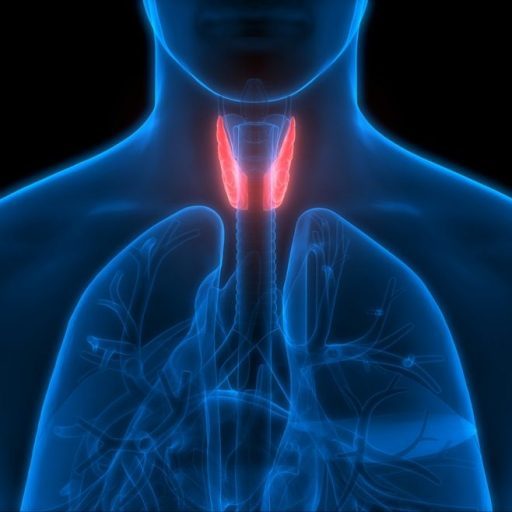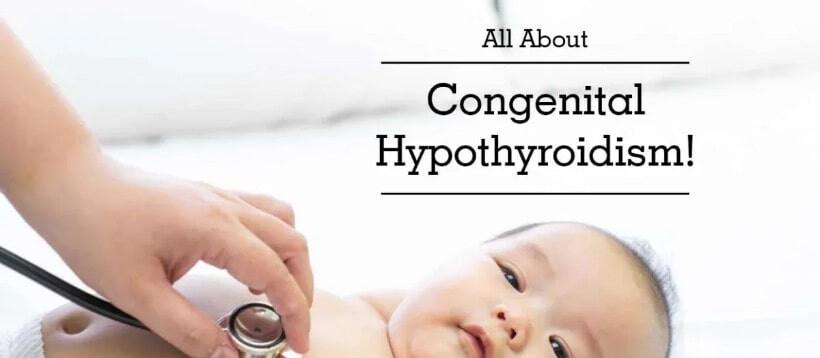Before looking into the intricacies of Congenital Hypothyroidism in newborns, we need to discuss the Thyroid. The thyroid gland system, which consists of the thyroid gland and two specialized brain centers known as the hypothalamus and pituitary, forms and almost completely matures while a baby is developing in the uterus. Early in the first trimester of pregnancy, embryonic tissues located at the base of the developing baby’s tongue grow into a bi-lobed thyroid gland that resembles a butterfly in its shape.
Through a process referred to as “differential migration”, the thyroid gland “descends” from the base of the tongue to its final destination just below the thyroid cartilage (i.e., Adam’s Apple) in the front of the neck. By the end of the first trimester, the thyroid gland is not only located in its normal location in the neck, but it is also capable of collecting iodine and other raw materials from the fetal circulation for the production of thyroid hormone.
During the time that the thyroid gland develops, the hypothalamus and pituitary also develop. Early in the second trimester, the hypothalamus specifically begins to signal the pituitary to produce and release a messenger hormone known as thyroid-stimulating hormone (TSH) into the fetal blood stream.
Second Semester
Through the second trimester, TSH levels rise in the fetal blood, and, as a result, stimulate the thyroid gland to grow properly and to begin to produce thyroid hormone. In a manner that resembles an assembly line process, thyroid gland cells take iodine and other raw materials (e.g., amino acids) from the fetal blood stream and convert them, through a series of enzymatic reaction steps, into thyroid hormone.
Thyroid hormone originates from a large protein, thyroglobulin. Interestingly, this protein is stored within the thyroid gland. Furthermore, an intricate series of enzymatic reactions occur. As a result, the thyroid hormone detaches from the thyroglobulin molecule. Finally, it gets released into the blood stream.

Third Semester
Through the second and the third trimesters, the complex mechanisms that regulate the hormonal interactions between the hypothalamus, pituitary, and thyroid gland gradually mature. As these mechanisms mature, the thyroid gland system becomes more and more finely tuned to produce and release just the right amounts of thyroid hormone into the developing baby’s blood stream.
Full Term
By the time the baby reaches full term, the thyroid gland system is entirely functional and ready to provide all the newborn baby’s requirements for thyroid hormone. The continuous maintenance of proper thyroid hormone levels from the newborn period through childhood is absolutely essential for normal postnatal physical growth and brain development.
If any portion of the developing baby’s thyroid gland system fails to either form or function correctly, then he/she may become hypothyroid. Hypothyroidism that is present from birth is referred to as congenital hypothyroidism (CH). In North America, CH occurs in about 1 in 4000 live-born babies. The majority (over 90%) of affected babies in North America have a permanent, life-long type of CH.
In these babies, delayed diagnosis (i.e., beyond 2 to 3 months of age) or improper treatment of hypothyroidism can lead to growth failure and/or irreversible mental retardation. On the other hand, diagnosis and initiation of appropriate thyroid hormone treatment within about the first 4 weeks of life, followed by regular clinic visits with physicians experienced in the treatment of CH, can prevent mental retardation and growth failure.
Permanent types of Congenital Hypothyroidism can be separated into the following 3 categories:
 1. Abnormalities of formation, migration, and growth of the thyroid gland (referred to as thyroid dysgenesis).
1. Abnormalities of formation, migration, and growth of the thyroid gland (referred to as thyroid dysgenesis).
In this category, the thyroid gland is either absent, markedly under-developed, or not in its proper location. About 80-85% of babies with CH fall into this category.
The exact cause of these disorders remains unknown.They occur sporadically, which means they are not inherited disorders. In addition, there is no evidence right now to suggest that either parent did, or failed to do, something to cause the CH to occur. The likelihood of two parents having more than one baby affected with this type of CH is only slightly higher than the original 1 in 4000 chance.
2. Abnormalities of enzymatic reaction steps involved in thyroid hormone production or release (referred to as thyroid dyshormonogenesis).
In this category, there is either a deficiency of or an abnormality in one of the many enzymatic reaction steps involved in thyroid hormone production or release.
About 10-15% of babies with Congenital Hypothyroidism fall into this category. The majority of these conditions are inherited as autosomal recessive disorders. This means that the affected child inherited the genes for CH from both the mother and the father. Therefore, the chance that CH will occur again in the family remains at 1 in 4 for each and every child born.
3. Abnormalities of the formation or function of the hypothalamus and/or pituitary (referred to as central hypothyroidism).
In this category, the thyroid gland develops and moves correctly. However, the pituitary gland doesn’t produce or release TSH correctly. Because of this, the thyroid gland lacks the TSH signal. This signal is crucial for the regular creation and dispersion of the thyroid hormone.
In this group, less than 5% of infants with Congenital Hypothyroidism fall. This category is associated with rare medical conditions known as central hypothyroidism. Some of these conditions occur randomly. Others, however, are genetic disorders.
TSH deficiency may happen alone. Alternatively, it can be in conjunction with other pituitary gland hormone deficiencies. It may also be tied to brain irregularities.
Along with permanent forms of CH, temporary ones exist as well. These are also known as transient forms of CH. In North America, about 10% of babies diagnosed with CH have a transient form.
Typically, these forms result from substances such as thyroid antibodies and medications. These substances travel from the mother’s bloodstream, across the placenta, and into the baby’s blood.
Once in the baby’s bloodstream, these substances then travel to the baby’s thyroid gland where they block the production of thyroid hormone. Often the mother of an affected child was receiving treatment for Graves’ hyperthyroidism during pregnancy, or she has a history of a thyroid disease.
Indeed, transient hypothyroidism can sometimes affect newborns. This condition is rather rare. However, it tends to appear in babies exposed to iodine-containing substances. For instance, x-ray dyes and certain skin cleansers contain iodine. This exposure often happens either at birth or shortly thereafter. Consequently, this causes the mentioned health condition. The transient forms of CH vary in their duration and may persist for several days to several months.
Diagnosis of Congenital Hypothyroidism
From a physician’s standpoint, Congenital Hypothyroidism can be extremely difficult to diagnose in a baby soon after birth. Even though there are “classic symptoms and signs” e.g.
- prolonged jaundice
- enlarged soft spots
- umbilical hernia
- poor feeding
- constipation
- cool or mottled skin
- increased sleepiness
- decreased crying, etc.
associated with CH, in the majority (~95%) of babies with CH, these findings are often very subtle and tend to go either undetected or unappreciated during the first few weeks of life.
Surprisingly, most parents discover their baby has CH unexpectedly. Typically, they portray their infants as “good babies.” Moreover, these babies rarely cry and aren’t demanding. Plus, they tend to sleep both day and night.
In North America, fortunately, newborns undergo CH screening soon after birth. This test is typically combined with others. For instance, tests for metabolic conditions like phenylketonuria (PKU) and galactosemia. Specifically, the main CH screening test measures the thyroid hormone, T4. They take this measurement from a blood spot sample.
Indeed, CH screening programs are highly effective. In fact, they detect nearly all children with CH. It’s vital, however, to understand these tests don’t provide a definitive diagnosis of CH.
 Screening for Congenital Hypothyroidism
Screening for Congenital Hypothyroidism
Consequently, if an infant tests positive for CH (low T4 level), a specialized physician must evaluate them. This check is crucial for confirming CH.
Screening programs have proven successful. Hence, most infants with CH get medical evaluation within their first month. This assessment includes a thorough history and physical examination. Blood tests measuring the baby’s thyroid hormone (T4 and free T4) and TSH levels are also necessary.
Moreover, the physician might conduct a thyroid scan or neck ultrasound. These tests check for thyroid tissue presence. Upon CH confirmation, timely initiation of thyroid hormone treatment is necessary. The dosage should match the infant’s age.
Ensuring the correct daily dose of thyroid hormone is vital. Once hormone therapy begins, regular monitoring becomes necessary. This oversight guarantees optimal thyroid hormone and TSH levels in the blood.
By tracking and adjusting thyroid hormone therapy, growth failure and mental retardation are preventable. Consequently, most children with CH grow and develop normally.









